Excerpts from Jim Conrad's
Naturalist Newsletter
from the November 15, 2009 Newsletter issued from Hacienda Chichen Resort beside Chichén Itzá Ruins, central Yucatán, MÉXICO; limestone bedrock, elevation ~39m (~128ft), ~N20.676°, ~W88.569°
BECARD ALONG THE ROAD
When I first hiked into the Hacienda I figured I'd be walking that same road many times, and I was right. It's the road I jog each morning just before dawn and also I walk there in early morning and late afternoon when the sun is low, flooding deeply into the scrub from the road, sometimes illuminating things that usually wouldn't be seen. On one such late-afternoon birdwalk I photographed the fast-foraging bird shown below:
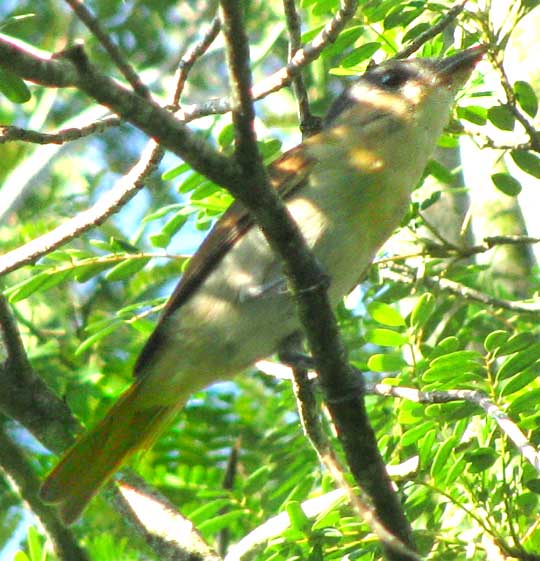
That's a female Rose-throated Becard, PACHYRAMPHUS AGLAIAE, common at forest edges, in open areas and the like from Mexico to Panama. During summers it spreads northward into extreme southern Texas and southern Arizona. Just the male has the rosy throat, making it easy to identify. The female is a bit more challenging, with its rusty back, pale underside and broad beak causing it to look like a Myiarchus flycatcher. The way the underside color extends around to the top of the neck, though, is fairly distinctive, as well as the dark cap. The call is a heartfelt, downward slurred tzeeeu.
Ornithologists haven't figured out exactly where to place becards on the bird branch of the evolutionary Tree of Life. At the moment they're being placed close to flycatchers, and when you see in the picture the bird's short, wide beak, that seems like a good bet.
from the January 22, 2012 Newsletter issued from Hacienda Chichen Resort beside Chichén Itzá Ruins, central Yucatán, MÉXICO; limestone bedrock, elevation ~39m (~128ft), ~N20.676°, ~W88.569°
HUNGRY BIRDS
Last Monday morning, everything seemed hungry, and I'm not sure why. Maybe it was because it was such a perfect, moist, warm, springy morning (despite all the dry-season-falling leaves) that many organisms, including myself, just felt like gorging on everything.
For example, even if you're familiar with Mexican birds you may not recognize the species in full adult-male plumage making a head-blurring stab into fruits of the dry-season leafless Gumbo-Limbo tree (Bursera simaruba) below:
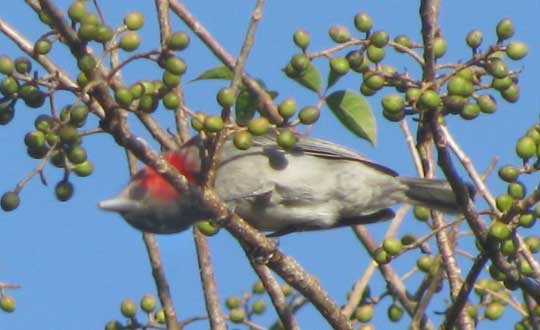
That bird's appearance is confusing because he's turned his head upside-down in order to get at something among the fruits. He's a Rose-throated Becard, with his rosy throat turned skywards.
from the January 31, 2016 Newsletter issued from Hacienda Chichen Resort beside Chichén Itzá Ruins, central Yucatán MÉXICO
MALE BECARD
With the dry season beginning and the days growing longer and warmer, our birds grow more and more active, visible and vociferous. A male Rose-throated Becard with his red throat ablaze and crown fluffed up making his big head seem even larger than usual is shown in an almost cocky pose below:
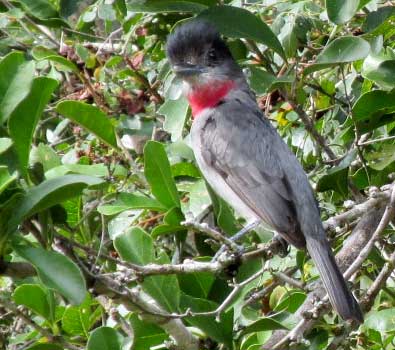
from the May 3, 2018 Newsletter issued from Rancho Regenesis in the woods ±4kms west of Ek Balam Ruins; elevation ~40m (~130 ft), N~20.876°, W~88.170°, central Yucatán, MÉXICO
BECARD NEST
In the papaya orchard right below the hut, a female Rose-throated Becard is building her nest these days. Below, you can see her just arrived to add a small leaf tatter to her nest, which is about 15ft (4.5m) up a Cedro tree:
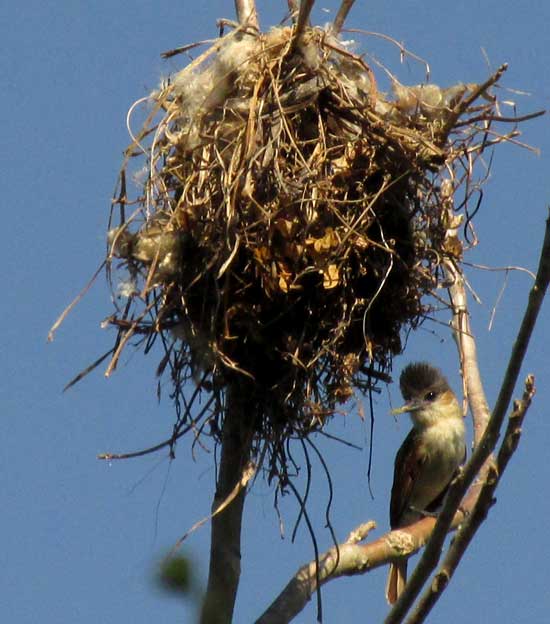
She looks like a flycatcher, but notice her thick beak and oversized head with a modest crest. Becards are closely related to flycatchers but are grouped in a different family, the New-World Tropics Cotinga Family, the Cotingidae. Below, you can see the female a few seconds after the above photo was taken, now about to add her leaf shred to the nest, and better showing how broad her black beak is:
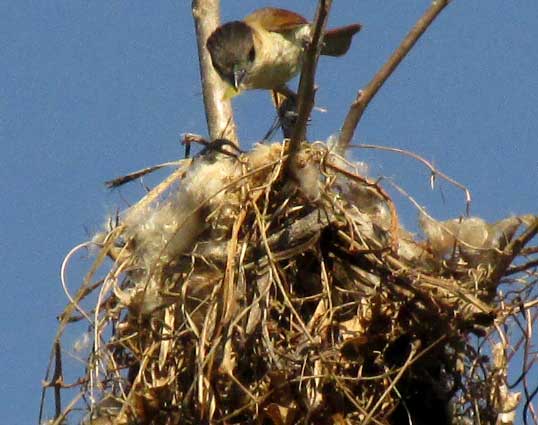
The nest was so large and messy looking compared to the little bird that I wondered whether she might not have taken over an old squirrel nest. However, in A Guide to the Birds of Mexico and Northern Central America, Steve Howell says that becards, genus Pachyramphus, produce nests that "... are bulky globular masses of fine dead leaves, fibers, moss, etc. with entrance near the bottom, slung from or wedged among outer branches at mid- to upper levels."
And that describes perfectly what's atop the Cedro tree down below the hut.